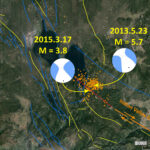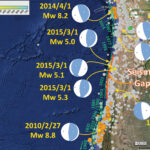I was taking a looksie at the different moment tensors for the years of 2000, 2010, 2014, and March 2015. I noticed that the transform plate boundary on the eastern side of the South Bismarck plate may separate segments of…
New Britain trench swarm
There have been a few aftershocks. I have outlines the region of the subduction zone that appears to have slipped in this March 2015 swarm. Here was my first post about the main shock and the tsunami notifications. I have…
New Britain trench seismicity: 2000 through March 2015
I have here placed the moment tensors for the large magnitude earthquakes along the New Britain trench for the time period from 2000 through March 2015. Note that the Mw 8.0 has a strike-slip moment tensor. There is a transform…
New Britain Earthquake Tsunami Update
The tsunami threat has now passed. There has been a single record of this tsunami so far. This is from the Pacific Tsunami Warning Center here. If one is ever interested in looking up information about tsunami warnings, watches, or…
Earthquake in the New Britain trench
We just had a large magnitude earthquake in the New Britain region, probably on the megathrust (subduction zone fault). There was a swarm of seismic activity in this region in July and August of 2010. Further to the southeast, there…
Earthquake in the New Britain trench
We just had a large magnitude earthquake in the New Britain region, probably on the megathrust (subduction zone fault). There was a swarm of seismic activity in this region in July and August of 2010. Further to the southeast, there…
Chile earthquakes in the 2010 slip region
We had a small flurry of earthquake activity in Chile today, along the subduction zone there. Today’s activity is in the the region of the 2010 earthquake sequence. The largest magnitude earthquake in today’s sequence is a M = 6.2.…
Molucca Earthquake
This region is a seismically active region. Today we had a M 6.2 earthquake. Here is the USGS web page for this earthquake. Last November, there were a series of large magnitude compression aearthquakes. Here are some posts about these…
Lake Almanor: Indian Valley fault activity
There was an earthquake swarm in this region in 2013. The largest magnitude earthquake had a magnitude of M = 5.7. Here is the USGS page for that earthquake. “Today” we got a M = 3.8 earthquake in this same…
Earthquakes in Chile: Between the 2010 and 2014 Slip Patches
There have been a few earthquakes in the region between the 2010 and 2014 Chile subduction zone earthquakes. This is a seismic gap that has not had a Great earthquake since 1977, a ~M = 8.5 earthquake that spanned the…


